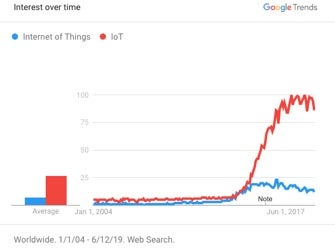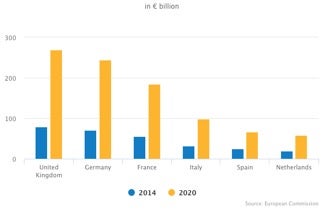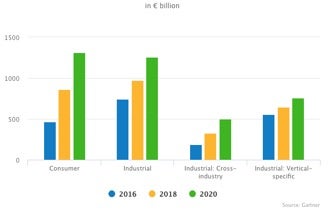IoT: International Framework
Technological Revolutions are quiet and astonishing. Step by step new technological applications are pushing existing paradigms and changing the way business is transacted by consumers, companies and in society. In the past, electricity and printing had a revolutionary role in social development, shifting all sectors of life. These days, the Internet of Things (IoT) is pivotal in creating quick, profound and quiet transformations.
According to the Committee on Digital Economy Policy of Directorate for Science, Technology and Innovation of OCED:
The Internet of Things (IoT) could soon be as commonplace as electricity in the everyday lives of people in OECD countries. As such, it will play a fundamental role in economic and social development in ways that would have been challenging to predict as recently as two or three decades ago[1].
In 2008-2009, according to Cisco IBSG - Internet Business Solutions, there were more connected objects, such as smartphones, tablets and computers, than the world's population. Therefore, this period is considered the year that IoT was born[2]. In 2008, Rob Van Kranemburg published “The Internet of Things”, which addresses a new paradigm in which objects produce information.
Supporting CISCO’s statement, the chart below of Google Trends shows the period of time during which popularity in searches on Google increased. In the last 5 years, IoT has sharply rocketed as a very attractive subject in the general mind of the people on the internet[3]:

Digging deeper we can see that IoT popularity is not only relevant to internet users or to some futuristic curiosity on Google, it is a real and concrete “combination of network connectivity, widespread sensor placement, and sophisticated data analysis techniques” which enables “applications to aggregate and act on large amounts of data generated by IoT devices in homes, public spaces, industry and the natural world”[4].
The potential benefits of this kind of connectivity are immense: real-time monitoring and more accurate metrics, the ability to remotely control various actions, interconnectivity and automation, plus the ease of handling a variety of devices that can be centralized on just one smartphone. Nonetheless, this technological avalanche also brings risks and vulnerabilities to users, such as increased vigilance over our habits, exposure of our personal data, hacking vulnerabilities, global or cascading failures, among others.
In the last two years, a set of supporting policy actions have been adopted by the European Commission to accelerate the take-up of IoT and to unleash its potential in Europe for the benefit of European citizens and businesses[5]. These policy actions and statements are not only a guess or shallow forecast, they are a serious result of data and market analysis that came from several studies which found impressive numbers such as 11 billion connected 'things' in 2018[6]. This could be as many as 20 billion connections by 2020[7], about 6 billion of which will be in Europe[8]. Of these, 60-65% are consumer devices.
According to the Centre for the Promotion of Imports (CBI) more than 65% of businesses are expected to use IoT products by 2020, compared to 30% in 2017. Europe accounts for more than a third of global Industrial IoT investments by 2020. The market is expected to grow at an impressive average annual rate of 22%. Reaching a value of €287 billion in 2020, Industrial IoT is Europe’s largest IoT market[9].
Seizing the Benefits and Addressing the Challenges
The Centre for the Promotion of Imports (CBI), an Agency of the Netherland’s Ministry of Foreign Affairs and part of the development cooperation effort of the foreign relations of the Netherlands conducted research on the IoT in Europe in January 2019. It concluded:
The European market for Internet of Things (IoT) solutions is growing. Western and Northern Europe are especially promising. Both consumer and business IoT offer opportunities, but specialisation may give you a competitive advantage. The home, health and finance sectors are front runners. National and European initiatives are working to stimulate the roll-out of Industrial IoT solutions and lower barriers. The shortage of skilled specialists continues to drive outsourcing[10].
Apart from an advantageous and “smart” business opportunity, IoT can facilitate innovation in the private sector supporting a wide range of innovative businesses, not only raising the productivity level but increasing the accountability and responsiveness of companies and its employees, improving the client confidence.
Thus, IoT can work to facilitate Private Sector Innovation by so-called industrial Internet, Next Production Revolution (NPR)[11], autonomous machines and big data[12] and automotive industry[13]. On the other hand, innovative Public Sector Delivery with IoT applications could provide smart cities[14], smart governments, smart street lighting[15] and traffic flow optimization[16], innovation in healthcare practice and delivery[17]. IoT technologies are, therefore, expected to play a major role in improving the management of transport, energy use, water services, education, employment, health, crime prevention, by making society more efficient, innovative, safe, sustainable, and inclusive[18].
Regardless of all the benefits, there are many challenges and risks associated with IoT digital security, such as cyber attacks, digital incidents and privacy challenges. Furthermore, bad outcomes can happen causing physical consequences in case of the wrongdoing of autonomous vehicles, health care tools or industrial machines.
The Vision of IoT in 2020
First of all, the 2020 scenario might be approached by a combination of the Cloud and Big Data. Nowadays the hyperconnectivity[19] of society drives IoT to be “The Next Big Thing” in business. According to OECD this next big thing will be related to “a sophisticated industry ecosystem consisting of vendors (providing components), suppliers (creating solutions), service providers, and enterprise users in all sectors of the economy” that will be “measured in billions of Euro in Europe alone, and that will extend across the world too”[20].
Could expectations be too high? Maybe not, because of the following points: I) the centrality of IoT in the upcoming years is corroborated by the sheer number of connections that are expected to be in place by 2020; II) IoT ecosystem will have grown to encompass not only the traditional supply-side actors, but also a rising number of businesses and organizations serving and using IoT; III) hyper-connected society will be an established reality by 2020, as most of the “things” that can be connected, will be by then.
In 2018, the World Economic Forum (WEF) published a study considering initiatives on the future of production. Essentially, it gives an insight into: I) Solution-driven: technology can tackle and solve challenges that have previously been insurmountable; ii) Human-centric: technology can unlock human potential by unleashing creativity, innovation and productivity in new ways; iii) Sustainable: technology can promote sound production processes that minimize negative environmental impact, conserve energy and resources and enable carbon neutrality; iv) Inclusive: employees, companies and countries at different stages of development benefit from Fourth Industrial Revolution technologies and the transformation of production systems[21].
One of its conclusions is that in the coming years, the IoT market is expected to grow across Europe. Most of the front runners are Western European countries, which have traditionally invested more in IT. And together, six countries make up more than 75% of the European IoT market, this makes them especially promising target markets for 2020.

Further, apart from the geographic localization of the opportunities arising, to have a real and concrete overview it is important to be aware of the market size and 2020 forecast by sector. By 2020, industrial IoT is predicted to consist of:
- 60% cross-industry devices - used in multiple industries, mainly to save costs;
- 40% vertical-specific devices - used in a specific industry to improve efficiency/accuracy.
- Industrial IoT also offers good opportunities, as the average spending per device is much higher in this sector. This makes total spending on consumer and industrial IoT about equal by 2020[22].

Based on the US Dollar: Euro exchange rates in October 2018, the global average spending on IoT devices is expected to be:
- €102 per consumer device;
- €114 per cross-industry business device;
- €239 per vertical-specific business device.
Finally, electronic sensors are now everywhere - in smartphones, cars, home electronic systems, healthcare devices, fitness monitors and in the workplace. It has been estimated that, by 2020, over 200 billion sensor devices will be inter-connected, creating a market size that, by 2025, will be between $2.7 trillion and $3 trillion a year[23].
At the same time, the market opportunity will bring regulatory challenges. The next section of this report will analyze by specific studies the impact of regulatory requirements on IoT devices and deployment.
[1] OCDE. Committee on Digital Economy Policy of Directorate for Science, Technology and Innovation. The Internet of Things: Seizing the Benefits and Addressing the Challenges. Background Report for Ministerial Panel 2.2. English Version. 24 May 2016. P. 5. Available here.
[2] MANCINI, Monica. Internet das Coisas: História, Conceitos, Aplicações e Desafios. Available here.
[3] Interest over time. Numbers represent search interest relative to the highest point on the chart for the given region and time. A value of 100 is the peak popularity for the term. A value of 50 means that the term is half as popular. A score of 0 means there was not enough data for this term. The information is available here.
[4] Idem, p. 5.
[5] European Commission. Digital Single Market. Policies: Internet of Things. Available here.
[6] Gartner, Inc. Press Release. Gartner Says 8.4 Billion Connected "Things" Will Be in Use in 2017, Up 31 Percent From 2016. February 2017. Available here.
[7] Idem, Leading the IoT. Gartner Insights on How to Lead in a Connected World. 2017. P. 2.
[8] European Commission. Definition of a Research and Innovation Policy Leveraging Cloud Computing and IoT Combination. FINAL REPORT. A study prepared for the European Commission. DG Communications Networks, Content & Technology. Digital Agenda for Europe. Available here.
[9] Netherlands Ministry of Foreign Affairs. Centre for the Promotion of Imports (CBI). January 2019. Available here.
[10] Netherlands Ministry of Foreign Affairs. Centre for the Promotion of Imports (CBI). January 2019. Available here.
[11] (NPR) entails a confluence of technologies ranging from a variety of digital technologies (e.g. 3D printing, the Internet of Things [IoT] and advanced robotics) to new materials (e.g. bio- or nano-based) to new processes (e.g. data-driven production, artificial intelligence [AI] and synthetic biology). The Next Production Revolution. A Report to G20. OECD, 2017. Available here.
[12] Autonomous machines and the use of big data are increasingly present in agriculture. Robots can now sort plants based on optical recognition, harvest lettuce and recognise rotten apples. Idem, Ibidem.
[13] The automotive industry is one of the sectors most affected by interconnectivity and enhanced efficiency in both production and operation of vehicles. Idem, Ibidem.
[14] “Smart city plans explore the ability to process huge masses of data coming from devices such as video cameras, parking sensors and air-quality monitors to help local governments achieve goals in terms of increased public safety, improved environment and better quality of life. In: OCDE. Committee on Digital Economy Policy of Directorate for Science, Technology and Innovation. The Internet of Things: Seizing the Benefits and Addressing the Challenges. Background Report for Ministerial Panel 2.2. English Version. 24 May 2016. P. 16.
[15]“Dublin (Ireland), Oslo (Norway) and Chattanooga, Tennessee in the United States have started to use smart street lighting systems.29 Often triggered by replacing municipal lighting with LED solutions to save on energy costs, smart street lighting can offer combined savings of up to USD 100 per streetlight per year”. Idem, Ibidem.
[16]“The SCOOT system developed by Transport for London uses data on road usage with real-time control of traffic lights in the city to deliver on average a 12% improvement in traffic flow. Other large cities, like Beijing, São Paulo, Toronto or Preston have introduced SCOOT”. Idem, Ibidem.
[17] “Smaller sensors, smartphone assisted readouts, big data analysis and continuous remote monitoring can enable new ways of managing care. Such a digital health feedback system includes wearable and that work together to gather information about medication-taking, activity and rest patterns. Idem. p.15.
[18] UN General Assembly, Report of the Special Rapporteur on the promotion and protection of the right to freedom of opinion and expression, A/HRC/32/38 (2016), P.12.
[19] A term invented by Canadian social scientists Anabel Quan-Haase and Barry Wellman, it refers to the use of multiple means of communication, such as email, instant messaging, telephone, face-to-face contact and Web 2.0 information services.
[20] OCDE. Committee on Digital Economy Policy of Directorate for Science, Technology and Innovation. The Internet of Things: Seizing the Benefits and Addressing the Challenges. Background Report for Ministerial Panel 2.2. English Version. 24 May 2016. P. 24.
[21] World Economic Forum. Insight Report. Readiness for the Future of Production. Report 2018. Available here.
[22] Netherlands Ministry of Foreign Affairs. Centre for the Promotion of Imports (CBI). January 2019. Available here.
[23] Russo et al. Exploring regulations and scope of the Internet of Things in contemporary companies: a first literature analysis. Journal of Innovation and Entrepreneurship, 2015, P. 5.



 />i
/>i
